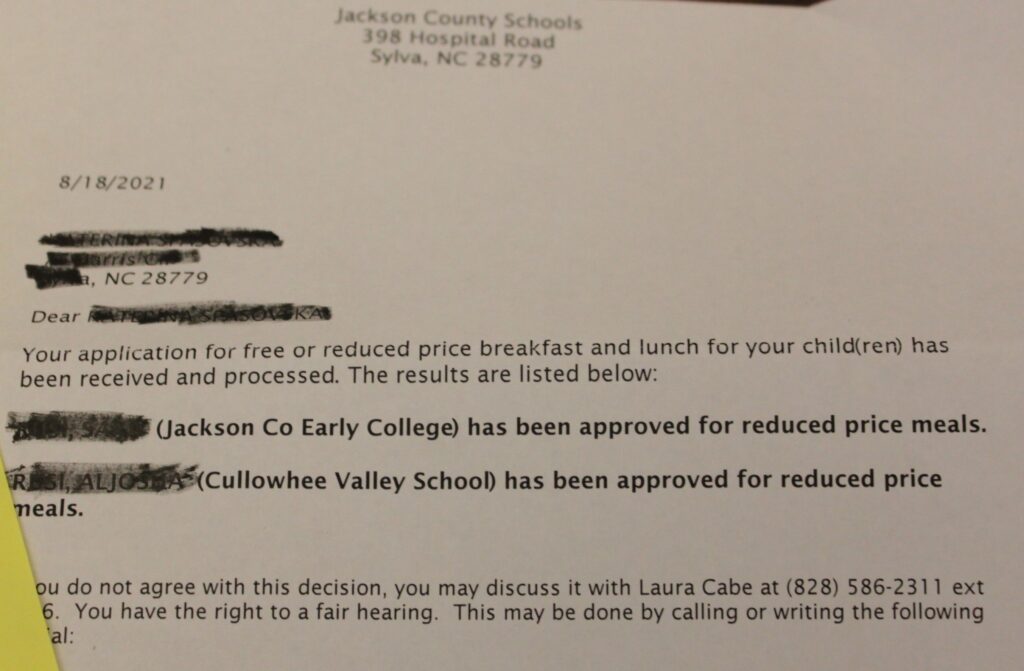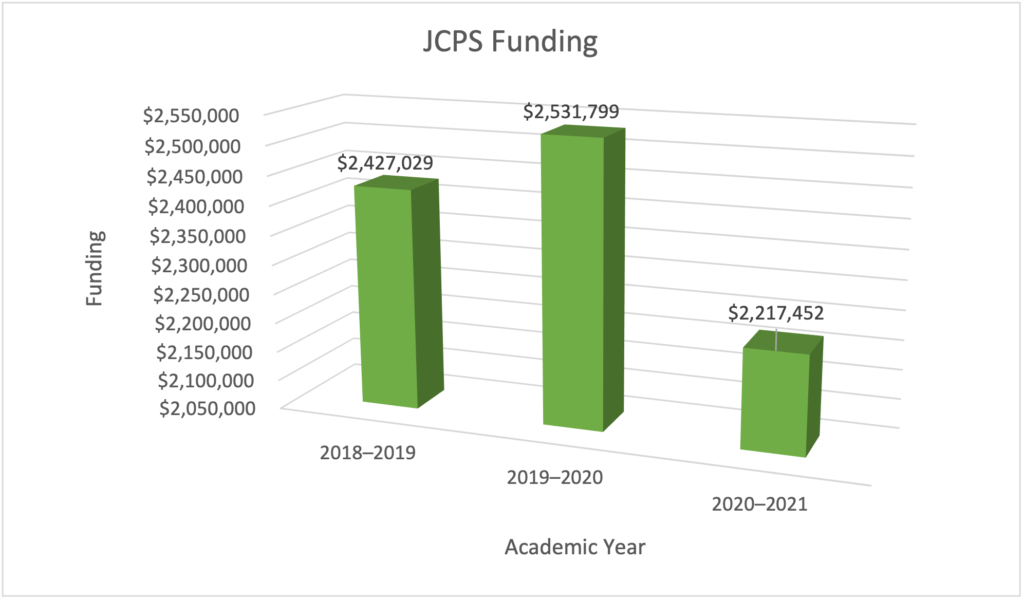Originally published in The Western Carolinian.
As another year of schooling starts, Jackson County Public Schools continues to fight its food insecurity among students.

In 2019, Carolina Public Press reported that one in four children faces food insecurity in Western North Carolina. COVID-19 struck the U.S. the following year.
Due to the United States Department of Agriculture’s ruling, requirements to receive free or reduced lunch during the 2020-2021 academic year were waived. This program was continued for the 2021-22 school year.
“All kids across the district, no matter their income household size, which is a qualifying factor to participate in free or reduced meals, everyone is eating at no cost this year,” said School Nutrition Director Laura Cabe. “Nobody has to fill out an application to benefit from the program.”
Even though applications were not required, parents were still requested to complete it online or in-person form due to the long-term impacts on future funding from the federal government, especially after COVID-19 meets its conclusion and universal free lunch ceases to exist.
“We don’t receive any state money or public funds to help run our program, so we rely basically everything on the reimbursement we receive from the federal government, which is based on those meals that we provide as well as anything that we sell,” Cabe explained.
The USDA revises the income eligibility guidelines on an annual basis. This is similar to the 2019–2020 school year.
| Household Size | Income Eligibility Guidelines (2020–2021) | ||||
| Number of Members | Year | Month | Twice Per Month | Every Two Weeks | Weekly |
| 1 | $23,606 | $1,968 | $984 | $908 | $454 |
| 2 | $31,894 | $2,658 | $1,329 | $1,227 | $614 |
| 3 | $40,182 | $3,349 | $1,675 | $1,546 | $773 |
| 4 | $48,470 | $4,040 | $2,020 | $1,865 | $933 |
| 5 | $56,758 | $4,730 | $2,365 | $2,183 | $1,092 |
| 6 | $65,046 | $5,421 | $2,711 | $2,502 | $1,251 |
| 7 | $73,334 | $6,112 | $3,056 | $2,821 | $1,411 |
| 8 | $81,622 | $6,802 | $3,401 | $3,140 | $1,570 |
| EachAdditional Member Add | $8,288 | $691 | $346 | $319 | $160 |
Source: SchoolNutritionAndFitness.com
According to Cabe’s records, 40% of JCPS received free or reduced lunch this year compared to an average of 58% in previous years.
For example, at Scotts Creek Elementary, 58.93% of students received free lunch this school year compared to 66.21% in 2019–2020.
Principal April Bryson of SCE recognizes the program’s success and acknowledges the need for increased awareness.
“I think the biggest challenge in Western North Carolina is just making sure that everyone knows about the program and that they are able to register to get this food for their children,” Bryson said in an email. “It’s been a wonderful program for tackling food insecurity.”
The overall decrease in applicants can also lead to other severe complications throughout all JCPS.
“Most people do think that it just benefits them, but it benefits the school system based on their free and reduced percent,” Cabe said. “For instance, Title I program that helps students in the school system, they benefit off that as well as testing. As far as testing goes, computers, technology, things like that. So, there are many other programs that affect when the free reduced percent drops like that.”
The amount of funding the program receives has varied over the years.

COVID-19 has severely affected the program financially, showing a loss of $205,032 in the first six months.
“That was from the meals, snacks, just everything that we weren’t able to sell,” she said. “We have lost that much money, especially from any kind of snacks, extra a la carte. If we have pizza on the menu typically, we have kids come buy two pieces of pizza, so we didn’t have that for months, and so basically July to December, it looks like we have lost almost $200,000 in supplemental sales as well as just participation.”
The lack of participation throughout the county negatively correlates with the number of meals served. The number of meals served dropped by 124,700 or 47%.

While students are taking their coursework through a hybrid format, JCPS has provided food to its students through pickup sites.
“Right now, here in the community is Smoky Mountain High School,” Cabe said. “That’s our designated location here in town. We have Blue Ridge School up in Cashiers and then we have Smokey Mountain Elementary School, which is located in Whittier, and anybody that picks up the only qualifying thing is they have to be under the age of 18 to qualify. They do not have to be enrolled in Jackson County schools to participate.”
On April 20, the USDA announced the expansion of universal free lunch through June 2022. It is unknown whether the program will still be in place after that.
The following are meal prices from 2019 and what parents and students alike can expect once the program ends next year.
Breakfast: Lunch:
Free/Reduced: $0.00 Free: $0.00
Reduced: $0.00 Reduced: $.40
Paid: $1.25 Paid: Pre-K – Third $ 2.55
Fourth – Eighth – $2.70
Ninth – Twelfth – $2.80
When a student cannot afford a meal and has not signed up for free or reduced lunch, they can charge up to $10. After that, they will receive an alternative meal. However, in high school, students are not allowed to charge at all, so they will automatically receive an alternative meal if they do not have money on their account or in hand. The alternative meal is quite noticeable from regular meals that students buy. The alternative meal includes a cheese sandwich, fruit, vegetable, and milk. This is noticeably quite different from traditional hot meals that students buy. Therefore, JCPS established the Angel Fund.
“We will move money from that Angel Fund into that student’s account to cover that cost of that meal,” Cabe said. “After they use it three times, I’ll call the family and see what’s going on. A lot of the times, they don’t realize it, or they haven’t filled out a meal application, but it’s a great thing because we have not had to do that for any child or shame them or not provide them a hot meal like the others in years, it’s been a very neat program, very successful program.”
Even though COVID-19 has drastically changed the food programs at JCPS, the importance of the fund is still stressed.
“This year, we haven’t had to use it, but we still have people donating to it and we just let them know that once we go back to the national school breakfast and lunch programs, we’ll start using that again,” she said.
To apply for free or reduced lunch, click here. To learn more about the Angel Fund, click here.


